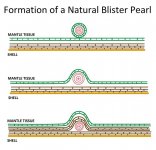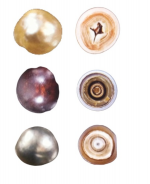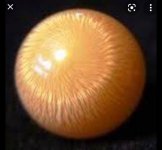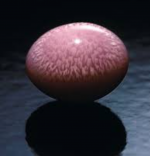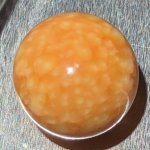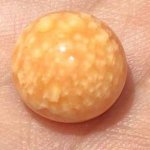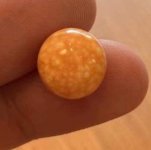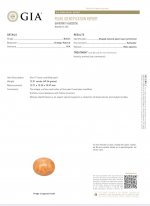You are using an out of date browser. It may not display this or other websites correctly.
You should upgrade or use an alternative browser.
You should upgrade or use an alternative browser.
How looks melo pearl and conch pearl inside
- Thread starter A.Oliver
- Start date
CortezPearls
PG Forum Admin
- Joined
- Aug 26, 2005
- Messages
- 4,109
Hello A.Oliver and welcome to our forum again 
I understand it will be difficult to find an image of an actual Melo pearl cut in half...their rarity will make it very difficult for someone to agree to cut one!
The best I could think of would be an Xray...but X rays are known to alter pearl color in conch pearls and it could be the same on melos...tough!
BUT I have to say that ALL PEARLS will have the same inner structure: that of an onion. Thus, that image of pearls cut in half will be quite accurate to describe a Melo pearl.
I understand it will be difficult to find an image of an actual Melo pearl cut in half...their rarity will make it very difficult for someone to agree to cut one!
The best I could think of would be an Xray...but X rays are known to alter pearl color in conch pearls and it could be the same on melos...tough!
BUT I have to say that ALL PEARLS will have the same inner structure: that of an onion. Thus, that image of pearls cut in half will be quite accurate to describe a Melo pearl.
Hello!)
is it worth comparing conch and melo with pearls from this article? After all, outwardly they are similar and have flames:
https://www.gia.edu/gems-gemology/s...me-structure-pearls-from-bivalves-tridacnidae
Although after reading this article to the end, I, like the authors of the article, realized that it would not be possible to fully understand the structure of pearls until they cut it in half.
And if, for example, draw the structure of the growth of melo/conch pearls, with layers similar to an onion, then how to depict the tongues of flame on the sketch?
This is really interesting
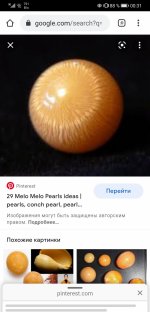
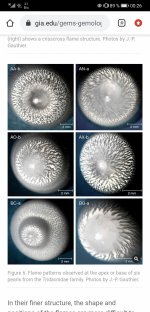
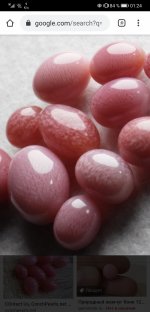
is it worth comparing conch and melo with pearls from this article? After all, outwardly they are similar and have flames:
https://www.gia.edu/gems-gemology/s...me-structure-pearls-from-bivalves-tridacnidae
Although after reading this article to the end, I, like the authors of the article, realized that it would not be possible to fully understand the structure of pearls until they cut it in half.
And if, for example, draw the structure of the growth of melo/conch pearls, with layers similar to an onion, then how to depict the tongues of flame on the sketch?
This is really interesting



CortezPearls
PG Forum Admin
- Joined
- Aug 26, 2005
- Messages
- 4,109
I apologize that my question was posted three times, there must have been an error
It sometimes happens! Don't worry
CortezPearls
PG Forum Admin
- Joined
- Aug 26, 2005
- Messages
- 4,109
Hello!)
is it worth comparing conch and melo with pearls from this article? After all, outwardly they are similar and have flames:
https://www.gia.edu/gems-gemology/su...es-tridacnidae
Although after reading this article to the end, I, like the authors of the article, realized that it would not be possible to fully understand the structure of pearls until they cut it in half.
And if, for example, draw the structure of the growth of melo/conch pearls, with layers similar to an onion, then how to depict the tongues of flame on the sketch?
This is really interesting
You don't depict the "flame pattern" because from the inside you cannot actually see it, it is an optical effect that is better seen on the surface. I would prove this by cutting a conch pearl I have...but I would loose it!

SteveM
Well-known member
- Joined
- Jan 29, 2007
- Messages
- 2,081
Just to add that the round orangish pearl on black background is a cassis cornuta of mine, and one of my luckier shots with an old point-and-shoot camera about 12 years ago. Still have the pearl and also would be very reticent about cutting it!!
I don't think there was ever a satisfactory explanation for the formation of these (assuming the vortical form observed via transmitted light is not a surface phenomenon).
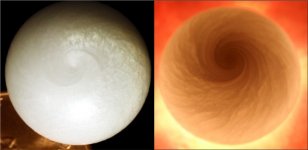
I don't think there was ever a satisfactory explanation for the formation of these (assuming the vortical form observed via transmitted light is not a surface phenomenon).

CortezPearls
PG Forum Admin
- Joined
- Aug 26, 2005
- Messages
- 4,109
Hey Steve! Nice to have you back 
And good to have your extra info to add it up. I remember when we were looking at those vortex-like patterns on your pearls...over a decade ago??? Wow...time sure flies!
And good to have your extra info to add it up. I remember when we were looking at those vortex-like patterns on your pearls...over a decade ago??? Wow...time sure flies!
Lagoon Island Pearls
Well-known member
- Joined
- Dec 8, 2009
- Messages
- 2,122
I don't think there was ever a satisfactory explanation for the formation of these (assuming the vortical form observed via transmitted light is not a surface phenomenon).
I've not seen anything that describes the phenomenon either, but I do have suggestions as to why it occurs. One only needs to see the lattice patterns on a shell to gather how this may be manifested into flame patterns. These patterns can be likened to the "pinto like" appearance of the shells of many mollusk species which change from white to brown and back again on the next cycle (lot's of exceptions, but a rule nonetheless)
E-cell behavior is not constant. It changes markedly during each growth cycle. After each successive monthly quiescence period, juvenile cells produce clear proteins and precipitate discrete aragonite crystals. Later in the cycle, as the cell becomes overworked (for lack of a better term), the proteins become darker and aragonitic production gives way to calcitic formations. In the course of successive growth cycles, may be manifested as flame patterns in some species or effervescent patterns in the case of my pearls. This rate varies widely between species, hence some display flame patterns more than others and some not at all.
This is why pearls are mainly harvested in winter months, just as they come out of annual quiescence when the proteins are most clear and the aragonite crystals are most discrete. This results in higher luster and more defined orient.
"Reversion" however, is well described by scholars and probably not immediately related (yet cannot be ruled out) to flame patterns, but shells or pearls do not solely get larger by nature. All living things need calcium. During periods of environmental stress (ie) low salinity, pH imbalances, burial in sediments, hot/cold weather etc., mollusks have the ability to regulate their pH to uptake calcium from their shells and pearls. This is clearly evident at northern latitudes. During hot summer months, my pearls become highly calcitic and nearly opaque, yet after a few months of near freezing weather, that calcite is re-metabolized and the pearls appear deeply translucent again.
In French, sorry to say
CathyKeshi
Well-known member
- Joined
- Mar 16, 2014
- Messages
- 4,716
Really interesting reading; thank you all!
CortezPearls
PG Forum Admin
- Joined
- Aug 26, 2005
- Messages
- 4,109
Henri Hanni of the Swiss Gemmological Lab in Basel wrote a very interesting article about the flame structure in Conch pearls some years ago... lemme see..., yup!
2009 Explaining the Flame Structure in Non-Nacreous Pearls.
I will post 2 snippets of the article so you can see and read some of his findings...


2009 Explaining the Flame Structure in Non-Nacreous Pearls.
I will post 2 snippets of the article so you can see and read some of his findings...
CortezPearls
PG Forum Admin
- Joined
- Aug 26, 2005
- Messages
- 4,109
Interesting article Lagoon Island Pearls I still remember my first lab encounter with a blood cockle! I was not expecting red blood!
And what you say is accurate...all macroscopic lifeforms share this need to deposit nutrients (such as calcium carbonate, fat, sugars) into their bodily structures and then absorb them when required, in times of trial and tribulation.
And what you say is accurate...all macroscopic lifeforms share this need to deposit nutrients (such as calcium carbonate, fat, sugars) into their bodily structures and then absorb them when required, in times of trial and tribulation.
Lagoon Island Pearls
Well-known member
- Joined
- Dec 8, 2009
- Messages
- 2,122
Ahh yes, cockles. An excellent analog and a good point. Hemoglobin and iron pigmentation present considerably across this order (Cardiida). When we examine pearls from Tridacna gigas, the contrast is not as evident, if at all. This suggests flame patterns are almost entirely a mineral thing, while changes in coloration of proteins are merely indicators of structural differences during successive growth cycles.
Our friend and colleague, Ana Vasiliu authored a paper, which incidentally includes contributions from each of us in this discussion. While she does not speak to flame patterns specifically, she does discuss "fibrous aragonite" at length in terms of shell structure. We know reversion to be true on an annual basis, but presuming this is also true on a monthly basis it is reasonable to assume this uptake is not a perfect process. Instead, creating margins which may manifest in fractal patterns over time. After all, other anomalies such as chipped or broken shell repairs replicate themselves in successive growth cycles as well.
In the attached image, we see natural pearls from two expeditions to the same inventory. On the left, during the hot days of summer and on the right during the cold of winter. Pearls from these mussels are typically highly translucent, even up to ten years of age. This supports reversion may even surpass uptake from the surface to where underlying structures may also be involved. Especially during extreme conditions.

Our friend and colleague, Ana Vasiliu authored a paper, which incidentally includes contributions from each of us in this discussion. While she does not speak to flame patterns specifically, she does discuss "fibrous aragonite" at length in terms of shell structure. We know reversion to be true on an annual basis, but presuming this is also true on a monthly basis it is reasonable to assume this uptake is not a perfect process. Instead, creating margins which may manifest in fractal patterns over time. After all, other anomalies such as chipped or broken shell repairs replicate themselves in successive growth cycles as well.
In the attached image, we see natural pearls from two expeditions to the same inventory. On the left, during the hot days of summer and on the right during the cold of winter. Pearls from these mussels are typically highly translucent, even up to ten years of age. This supports reversion may even surpass uptake from the surface to where underlying structures may also be involved. Especially during extreme conditions.
CortezPearls
PG Forum Admin
- Joined
- Aug 26, 2005
- Messages
- 4,109
Nice samples Dave! I wish I had some to show....years and years ago (ages!) when I was (I should say WE WERE, because it was all done under teamwork, but its simpler to speak for myself) conducting my first pearl culturing studies with Rainbow lips, we were harvesting pearls almost year round (every month) in order to check nacre growth and other traits (luster) and there were a couple of things we noticed when we harvested in the coldest winter months: some of the pearls would look translucent silver, almost like glass beads , and during the hottest summer months, we would find that most pearls would be dull and coppery colored.
Somehow your photo reminded me of these two extremes.
Nice of you to post Ana's paper I did not remember it...it was so long ago and with so many things happening. Man, I remember John Lennon's lyrics "Life is what happens to you, while you're busy making other plans..." with all of this information.
I did not remember it...it was so long ago and with so many things happening. Man, I remember John Lennon's lyrics "Life is what happens to you, while you're busy making other plans..." with all of this information.
Anyway, this has become a very interesting thread and its due to the "spark of curiosity" and then the rich information that is shared. Thank you all
Somehow your photo reminded me of these two extremes.
Nice of you to post Ana's paper
Anyway, this has become a very interesting thread and its due to the "spark of curiosity" and then the rich information that is shared. Thank you all
Lagoon Island Pearls
Well-known member
- Joined
- Dec 8, 2009
- Messages
- 2,122
The other thing we've not touched upon is the sac itself. Stretch marks, as it were. Thinner sacs may hyper-extend resulting in large, single perforations where pearls partially emerge, but not irrupt. We know these as circle pearls. Other sacs, while remaining intact may stretch causing tiny perforations between the supporting fashia resulting in "raspberry" pearls. Then there are ripple pearls, where rather than presenting raised bumps, produce somewhat randomly elongated ridges while these extensions remain connected to, as opposed to perforated from the periphery.
I suspect minor recurring hyper-extension of the pearl sac may also give rise to flame patterns in some cases.
I can't say enough about Ana's vision. She poses the right questions to problem solving based on my imagery or observations in the field. She's obviously captured the attention (however tenuous that may be) of the powers that be at the paleo lab in Spain. Access to scanning or transmitting electron microscopy is out of reach to most. Reviewing my work from these views is a quantum leap in research. We evolved from simplistic surface analysis to complex structures and onsets. The evolution of this led us to preparing fixed cells for examination. That was okay for a time, but we quickly realized the need to examine the behavior of living, functional cells. The pearl industry depends on mononuclear periostracial displacement. Our work was to target anti-nuclear myostracial modification, if you will. The latter could be viable, perhaps even simpler if developed for cultural operations. If anything would reduce or eliminate surgical trauma/convalescence and produce multiple incidences in single specimens. Likewise, greatly reduced juvenile rearing periods.
This opened a door to a whole new world. Please excuse the off-topic comments, but they're important points worthy of repeating if we are to advance pearl technology beyond what know today. The industry has developed itself into a technical rut, where little to nothing has changed since Saville-Kent et al did their things so very long ago.
I suspect minor recurring hyper-extension of the pearl sac may also give rise to flame patterns in some cases.
Nice of you to post Ana's paperI did not remember it...it was so long ago and with so many things happening. Man, I remember John Lennon's lyrics "Life is what happens to you, while you're busy making other plans..." with all of this information.
Anyway, this has become a very interesting thread and its due to the "spark of curiosity" and then the rich information that is shared. Thank you all
I can't say enough about Ana's vision. She poses the right questions to problem solving based on my imagery or observations in the field. She's obviously captured the attention (however tenuous that may be) of the powers that be at the paleo lab in Spain. Access to scanning or transmitting electron microscopy is out of reach to most. Reviewing my work from these views is a quantum leap in research. We evolved from simplistic surface analysis to complex structures and onsets. The evolution of this led us to preparing fixed cells for examination. That was okay for a time, but we quickly realized the need to examine the behavior of living, functional cells. The pearl industry depends on mononuclear periostracial displacement. Our work was to target anti-nuclear myostracial modification, if you will. The latter could be viable, perhaps even simpler if developed for cultural operations. If anything would reduce or eliminate surgical trauma/convalescence and produce multiple incidences in single specimens. Likewise, greatly reduced juvenile rearing periods.
This opened a door to a whole new world. Please excuse the off-topic comments, but they're important points worthy of repeating if we are to advance pearl technology beyond what know today. The industry has developed itself into a technical rut, where little to nothing has changed since Saville-Kent et al did their things so very long ago.
CathyKeshi
Well-known member
- Joined
- Mar 16, 2014
- Messages
- 4,716
Finding the comments about circle, raspberry and ripple formation especially fascinating ... thanks Dave!
CortezPearls
PG Forum Admin
- Joined
- Aug 26, 2005
- Messages
- 4,109
Absolutely, and it is great that you diverge into seemingly unrelated topics (but actually, quite related!) and it all comes down -again- to the lack of research. I mean, things have indeed advanced from the times of Saville-Kent, Mikimoto & Vivés in some respects (we know much more about the pearl oyster's anal flap than ever before! And I kid you not...there are massive research articles written about the subject and money was poured into them!) but in other areas research is just bare or non-existent.
The way we do Science is not the best I guess...I actually began reading -today- a book called "The Tyranny of Metrics" (2018) by Jerry Z Muller and f just started to see more clearly the many issues in education and research were I worked at before...because the aim is based upon metrics that serve some people in their posts, but don't help anywhere else, especially where it matters most.
The way we do Science is not the best I guess...I actually began reading -today- a book called "The Tyranny of Metrics" (2018) by Jerry Z Muller and f just started to see more clearly the many issues in education and research were I worked at before...because the aim is based upon metrics that serve some people in their posts, but don't help anywhere else, especially where it matters most.
Khoirul Anam
Community member
- Joined
- Jan 13, 2023
- Messages
- 37
CortezPearls
PG Forum Admin
- Joined
- Aug 26, 2005
- Messages
- 4,109
Looks like a beautiful Melo melo pearl!
Luis_Mcdowell
New Member
- Joined
- Apr 27, 2023
- Messages
- 1
Sometimes it just happens! No worries, loves!I apologize that my question was posted three times, there must have been an error
Similar threads
- Replies
- 10
- Views
- 1K

